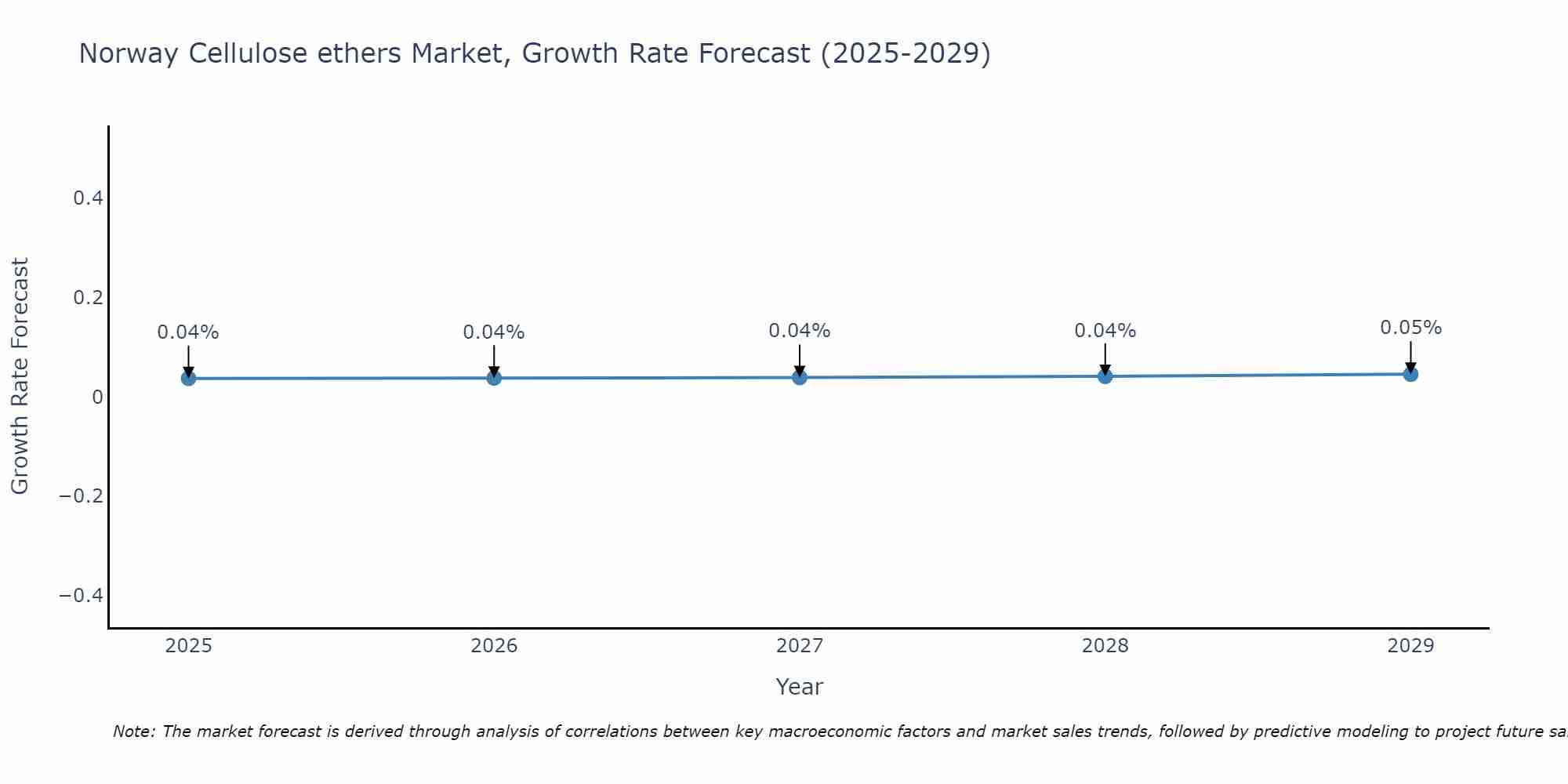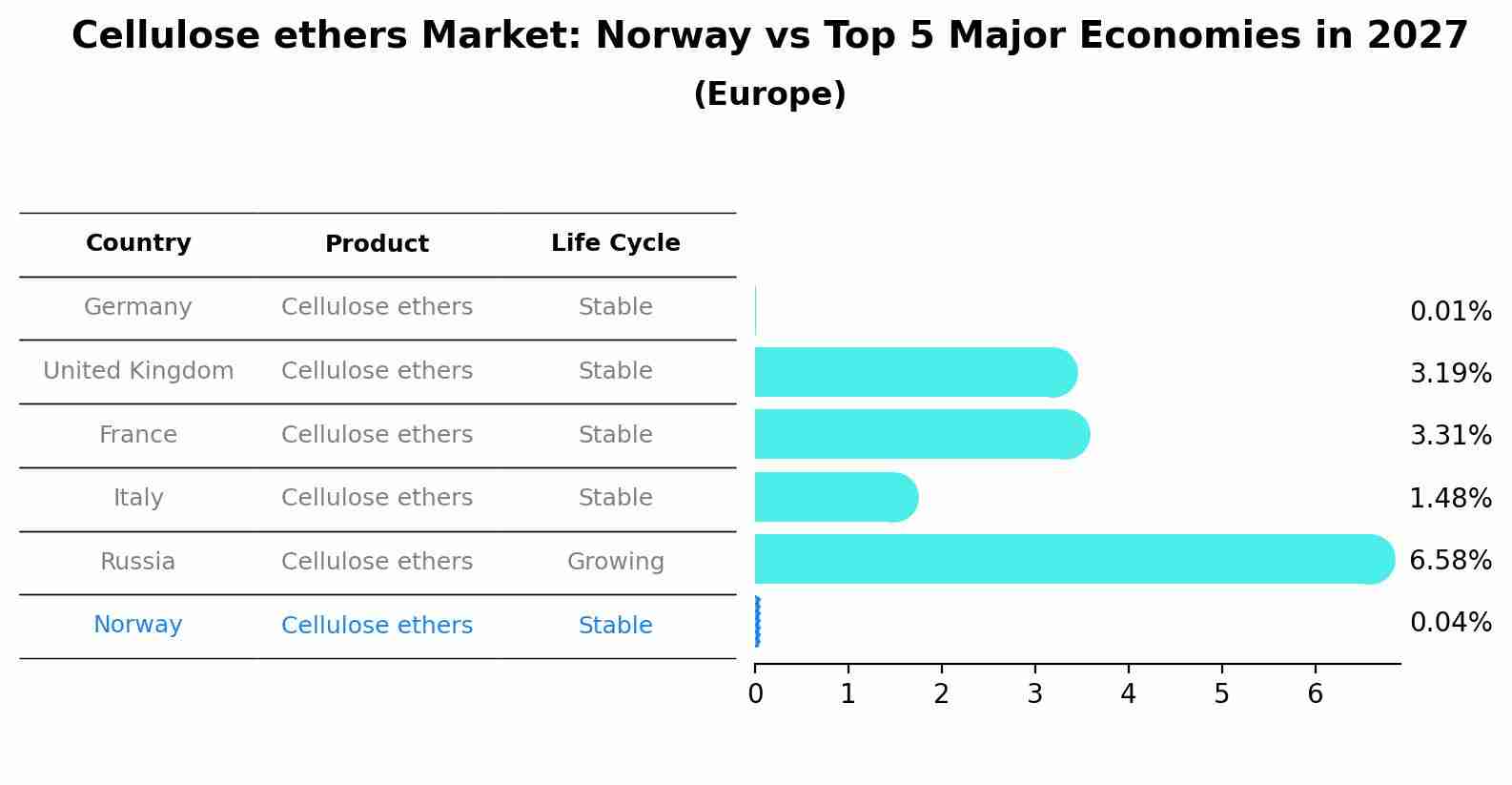Norway Cellulose ethers Market (2025-2031) | Segmentation, Forecast, Companies, Size, Growth, Value, Analysis, Revenue, Share, Outlook, Trends & Industry
| Product Code: ETC4704292 | Publication Date: Nov 2023 | Updated Date: Sep 2025 | Product Type: Market Research Report | |
| Publisher: 6Wresearch | Author: Shubham Deep | No. of Pages: 60 | No. of Figures: 30 | No. of Tables: 5 |
Norway Cellulose ethers Market Size Growth Rate
The Norway Cellulose ethers Market is likely to experience consistent growth rate gains over the period 2025 to 2029. From 0.04% in 2025, the growth rate steadily ascends to 0.05% in 2029.

Cellulose ethers Market: Norway vs Top 5 Major Economies in 2027 (Europe)
Norway's Cellulose ethers market is anticipated to experience a stable growth rate of 0.04% by 2027, reflecting trends observed in the largest economy Germany, followed by United Kingdom, France, Italy and Russia.

Norway Cellulose ethers Market Overview
The Cellulose Ethers market in Norway is expanding due to the versatile applications of cellulose ethers in industries such as construction, pharmaceuticals, and personal care. Cellulose ethers are used as thickeners, binders, and stabilizers in various products. Market growth is driven by advancements in cellulose ether technologies, increasing demand for functional additives, and the expanding use of cellulose ethers in different sectors.
Drivers of the market
The Norway Cellulose Ethers Market is propelled by its widespread use in the construction, pharmaceuticals, and food industries. Cellulose ethers` water retention, thickening, and stabilizing properties make them essential in products ranging from concrete to pharmaceuticals.
Challenges of the market
Challenges in the cellulose ethers market in Norway include fluctuating raw material costs and stringent environmental regulations governing production processes. Additionally, the market faces competition from synthetic alternatives that may offer more cost-effective solutions.
Government Policy of the market
The Norwegian government regulates the cellulose ethers market through a framework that emphasizes safety, environmental protection, and sustainability. Cellulose ethers, used in various applications including pharmaceuticals, food, and construction, are subject to strict regulations to ensure that they are produced and used safely. Norway aligns its policies with EU standards, particularly those set by the European Chemicals Agency (ECHA), to ensure the safe handling and use of these substances.
Key Highlights of the Report:
- Norway Cellulose ethers Market Outlook
- Market Size of Norway Cellulose ethers Market, 2024
- Forecast of Norway Cellulose ethers Market, 2031
- Historical Data and Forecast of Norway Cellulose ethers Revenues & Volume for the Period 2021-2031
- Norway Cellulose ethers Market Trend Evolution
- Norway Cellulose ethers Market Drivers and Challenges
- Norway Cellulose ethers Price Trends
- Norway Cellulose ethers Porter`s Five Forces
- Norway Cellulose ethers Industry Life Cycle
- Historical Data and Forecast of Norway Cellulose ethers Market Revenues & Volume By Product Type for the Period 2021-2031
- Historical Data and Forecast of Norway Cellulose ethers Market Revenues & Volume By Carboxymethyl Cellulose for the Period 2021-2031
- Historical Data and Forecast of Norway Cellulose ethers Market Revenues & Volume By Methyl Cellulose & Derivatives for the Period 2021-2031
- Historical Data and Forecast of Norway Cellulose ethers Market Revenues & Volume By Hydroxyethyl Cellulose for the Period 2021-2031
- Historical Data and Forecast of Norway Cellulose ethers Market Revenues & Volume By Others for the Period 2021-2031
- Historical Data and Forecast of Norway Cellulose ethers Market Revenues & Volume By Application for the Period 2021-2031
- Historical Data and Forecast of Norway Cellulose ethers Market Revenues & Volume By Food and Beverage for the Period 2021-2031
- Historical Data and Forecast of Norway Cellulose ethers Market Revenues & Volume By Pharmaceuticals and Healthcare for the Period 2021-2031
- Historical Data and Forecast of Norway Cellulose ethers Market Revenues & Volume By Construction for the Period 2021-2031
- Historical Data and Forecast of Norway Cellulose ethers Market Revenues & Volume By Cosmetics for the Period 2021-2031
- Historical Data and Forecast of Norway Cellulose ethers Market Revenues & Volume By Personal Care for the Period 2021-2031
- Historical Data and Forecast of Norway Cellulose ethers Market Revenues & Volume By Others for the Period 2021-2031
- Norway Cellulose ethers Import Export Trade Statistics
- Market Opportunity Assessment By Product Type
- Market Opportunity Assessment By Application
- Norway Cellulose ethers Top Companies Market Share
- Norway Cellulose ethers Competitive Benchmarking By Technical and Operational Parameters
- Norway Cellulose ethers Company Profiles
- Norway Cellulose ethers Key Strategic Recommendations
Frequently Asked Questions About the Market Study (FAQs):
1 Executive Summary |
2 Introduction |
2.1 Key Highlights of the Report |
2.2 Report Description |
2.3 Market Scope & Segmentation |
2.4 Research Methodology |
2.5 Assumptions |
3 Norway Cellulose ethers Market Overview |
3.1 Norway Country Macro Economic Indicators |
3.2 Norway Cellulose ethers Market Revenues & Volume, 2021 & 2031F |
3.3 Norway Cellulose ethers Market - Industry Life Cycle |
3.4 Norway Cellulose ethers Market - Porter's Five Forces |
3.5 Norway Cellulose ethers Market Revenues & Volume Share, By Product Type, 2021 & 2031F |
3.6 Norway Cellulose ethers Market Revenues & Volume Share, By Application, 2021 & 2031F |
4 Norway Cellulose ethers Market Dynamics |
4.1 Impact Analysis |
4.2 Market Drivers |
4.2.1 Increasing demand for green and sustainable products in various industries |
4.2.2 Growing awareness about the benefits of cellulose ethers in construction and pharmaceutical sectors |
4.2.3 Government initiatives promoting the use of eco-friendly materials in Norway |
4.3 Market Restraints |
4.3.1 Fluctuating prices of raw materials used in cellulose ethers production |
4.3.2 Stringent regulations related to environmental impact and waste management |
4.3.3 Competition from alternative products in the market |
5 Norway Cellulose ethers Market Trends |
6 Norway Cellulose ethers Market Segmentations |
6.1 Norway Cellulose ethers Market, By Product Type |
6.1.1 Overview and Analysis |
6.1.2 Norway Cellulose ethers Market Revenues & Volume, By Carboxymethyl Cellulose, 2021-2031F |
6.1.3 Norway Cellulose ethers Market Revenues & Volume, By Methyl Cellulose & Derivatives, 2021-2031F |
6.1.4 Norway Cellulose ethers Market Revenues & Volume, By Hydroxyethyl Cellulose, 2021-2031F |
6.1.5 Norway Cellulose ethers Market Revenues & Volume, By Others, 2021-2031F |
6.2 Norway Cellulose ethers Market, By Application |
6.2.1 Overview and Analysis |
6.2.2 Norway Cellulose ethers Market Revenues & Volume, By Food and Beverage, 2021-2031F |
6.2.3 Norway Cellulose ethers Market Revenues & Volume, By Pharmaceuticals and Healthcare, 2021-2031F |
6.2.4 Norway Cellulose ethers Market Revenues & Volume, By Construction, 2021-2031F |
6.2.5 Norway Cellulose ethers Market Revenues & Volume, By Cosmetics, 2021-2031F |
6.2.6 Norway Cellulose ethers Market Revenues & Volume, By Personal Care, 2021-2031F |
6.2.7 Norway Cellulose ethers Market Revenues & Volume, By Others, 2021-2031F |
7 Norway Cellulose ethers Market Import-Export Trade Statistics |
7.1 Norway Cellulose ethers Market Export to Major Countries |
7.2 Norway Cellulose ethers Market Imports from Major Countries |
8 Norway Cellulose ethers Market Key Performance Indicators |
8.1 Research and development investment in cellulose ethers technology |
8.2 Adoption rate of cellulose ethers in key industries |
8.3 Number of new product launches incorporating cellulose ethers |
8.4 Environmental sustainability metrics related to cellulose ethers production |
8.5 Customer satisfaction and feedback on the performance of cellulose ethers |
9 Norway Cellulose ethers Market - Opportunity Assessment |
9.1 Norway Cellulose ethers Market Opportunity Assessment, By Product Type, 2021 & 2031F |
9.2 Norway Cellulose ethers Market Opportunity Assessment, By Application, 2021 & 2031F |
10 Norway Cellulose ethers Market - Competitive Landscape |
10.1 Norway Cellulose ethers Market Revenue Share, By Companies, 2024 |
10.2 Norway Cellulose ethers Market Competitive Benchmarking, By Operating and Technical Parameters |
11 Company Profiles |
12 Recommendations | 13 Disclaimer |
- Single User License$ 1,995
- Department License$ 2,400
- Site License$ 3,120
- Global License$ 3,795
Search
Related Reports
- Uganda Excavator, Crane, and Wheel Loaders Market (2025-2031) | Strategy, Consumer Insights, Analysis, Investment Trends, Opportunities, Growth, Size, Share, Industry, Revenue, Segments, Value, Segmentation, Supply, Forecast, Restraints, Outlook, Competition, Drivers, Trends, Demand, Pricing Analysis, Competitive, Strategic Insights, Companies, Challenges
- Rwanda Excavator, Crane, and Wheel Loaders Market (2025-2031) | Strategy, Consumer Insights, Analysis, Investment Trends, Opportunities, Growth, Size, Share, Industry, Revenue, Segments, Value, Segmentation, Supply, Forecast, Restraints, Outlook, Competition, Drivers, Trends, Demand, Pricing Analysis, Competitive, Strategic Insights, Companies, Challenges
- Kenya Excavator, Crane, and Wheel Loaders Market (2025-2031) | Strategy, Consumer Insights, Analysis, Investment Trends, Opportunities, Growth, Size, Share, Industry, Revenue, Segments, Value, Segmentation, Supply, Forecast, Restraints, Outlook, Competition, Drivers, Trends, Demand, Pricing Analysis, Competitive, Strategic Insights, Companies, Challenges
- Angola Excavator, Crane, and Wheel Loaders Market (2025-2031) | Strategy, Consumer Insights, Analysis, Investment Trends, Opportunities, Growth, Size, Share, Industry, Revenue, Segments, Value, Segmentation, Supply, Forecast, Restraints, Outlook, Competition, Drivers, Trends, Demand, Pricing Analysis, Competitive, Strategic Insights, Companies, Challenges
- Israel Intelligent Transport System Market (2025-2031) | Strategy, Consumer Insights, Analysis, Investment Trends, Opportunities, Growth, Size, Share, Industry, Revenue, Segments, Value, Segmentation, Supply, Forecast, Restraints, Outlook, Competition, Drivers, Trends, Demand, Pricing Analysis, Competitive, Strategic Insights, Companies, Challenges
- Uganda Precast and Aggregate Market (2025-2031) | Strategy, Consumer Insights, Analysis, Investment Trends, Opportunities, Growth, Size, Share, Industry, Revenue, Segments, Value, Segmentation, Supply, Forecast, Restraints, Outlook, Competition, Drivers, Trends, Demand, Pricing Analysis, Competitive, Strategic Insights, Companies, Challenges
- Australia IT Asset Disposal Market (2025-2031) | Strategy, Consumer Insights, Analysis, Investment Trends, Opportunities, Growth, Size, Share, Industry, Revenue, Segments, Value, Segmentation, Supply, Forecast, Restraints, Outlook, Competition, Drivers, Trends, Demand, Pricing Analysis, Competitive, Strategic Insights, Companies, Challenges
- UAE Building Thermal Insulation Market Outlook (2025-2031) | Revenue, Companies, Share, Trends, Growth, Size, Forecast, Industry, Analysis & Value
- Portugal Electronic Document Management Market (2025-2031) | Strategy, Consumer Insights, Analysis, Investment Trends, Opportunities, Growth, Size, Share, Industry, Revenue, Segments, Value, Segmentation, Supply, Forecast, Restraints, Outlook, Competition, Drivers, Trends, Demand, Pricing Analysis, Competitive, Strategic Insights, Companies, Challenges
- France Electronic Document Management Market (2025-2031) | Strategy, Consumer Insights, Analysis, Investment Trends, Opportunities, Growth, Size, Share, Industry, Revenue, Segments, Value, Segmentation, Supply, Forecast, Restraints, Outlook, Competition, Drivers, Trends, Demand, Pricing Analysis, Competitive, Strategic Insights, Companies, Challenges
Industry Events and Analyst Meet
Our Clients
Whitepaper
- Middle East & Africa Commercial Security Market Click here to view more.
- Middle East & Africa Fire Safety Systems & Equipment Market Click here to view more.
- GCC Drone Market Click here to view more.
- Middle East Lighting Fixture Market Click here to view more.
- GCC Physical & Perimeter Security Market Click here to view more.
6WResearch In News
- Doha a strategic location for EV manufacturing hub: IPA Qatar
- Demand for luxury TVs surging in the GCC, says Samsung
- Empowering Growth: The Thriving Journey of Bangladesh’s Cable Industry
- Demand for luxury TVs surging in the GCC, says Samsung
- Video call with a traditional healer? Once unthinkable, it’s now common in South Africa
- Intelligent Buildings To Smooth GCC’s Path To Net Zero













